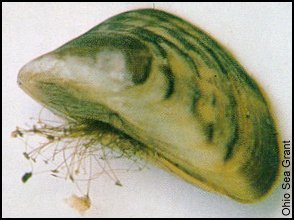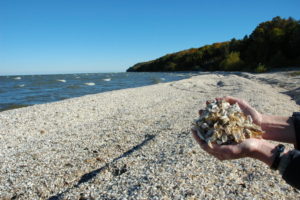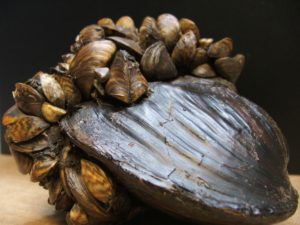Zebra Mussels – The Scourge of our Water Ecosystem
Zebra mussels get their name from the striped pattern of their shells. However, the pattern varies greatly to where there are no stripes, only dark or light colored shells. The mussels can grow to a maximum length of about 50 mm (5-10 mm in the first year) and live four to five years. A female mussel will produce between 30,000 and 1 million eggs in a year.
Where did they come from?
Native to Russia, zebra mussels were introduced into the Great Lakes in 1985 or 1986, when ships discharged ballast water into Lake St. Clair. Being a temperate mussel it found the plankton-rich Lakes St. Clair and Erie to their liking. Since this time, the zebra mussel have spread throughout the Great Lakes and beyond. Colonies have been found as far west as Oklahoma. Live zebra mussels have been found attached to recreational boats transported to Washington state.
What have they done to the lakes?
Originally, when zebra mussels entered Lake Erie, the public saw the positive impacts of their filter feeding that cleaned up the lake. These mussels contributed to the improvement of Lake Erie’s water clarity. Research shows that in the early ‘70s, water clarity was approximately 3 feet. It improved to 6 to 10 feet in the 1980s after a decade of reduced phosphorus inputs. It improved again to 10 to 17 feet in the early 1990s, after zebra mussels colonized the area. However, while the water may have better clarity, the negative impacts outweigh this one positive benefit.
One result of clearer water is increased vegetative growth, which may not be the best thing for anglers, boaters, swimmers and other aquatic recreation users.
Zebra mussels like temperate water and as a result there is a huge die off each year when the ice forms. When they wash up on shore in the spring, they can amass depths of 4-7 feet high.
Why are Zebra Mussels considered a nuisance?
Ecological Impacts – Zebra mussels have disrupted the traditional aquatic food chains of many inland lakes. Regardless of their size, inland lakes represent unique ecological systems. When zebra mussels enter into these fragile systems, their voracious filter feeding depletes the availability of microscopic organisms. These organisms play a critical part in each lake’s ecological food web. As a result, valued sportfish are impacted. Zebra mussels consume considerable amounts of these beneficial microscopic organisms. This creates less food for larval and juvenile fishes that support sport and commercial fisheries.
Biological Impacts – Zebra mussels are similar to other mussel species because they attach themselves to hard surfaces. However, unlike other species, zebra mussels will readily attach themselves to native mussels. They use the fine hair like legs to attach to any surface.
This behavior is known as bio-fouling and with the spread of these mussels, native mussel populations have been severely reduced. Some native mussels are more tolerant than others, but even for these resistant species, becoming covered by zebra mussels makes them more vulnerable to environmental stressors, such as extreme water temperatures, lack of food, or parasites and disease. As zebra mussels spread, biologists are concerned that populations of native mussels will decline, and perhaps some of the rarer species may be completely eliminated.
There’s More?
Economic Impacts – The zebra mussel attaches to hard surfaces located at moderate depths. This affinity for hard surfaces has made water intake structures, like those used for power and municipal water treatment plants, susceptible to colonization. Since 1989, some plants located in areas of extensive zebra mussel colonization have reported significant reductions in pumping capabilities and occasional shutdowns.
Human Health Impacts – As significant filter feeders, the mussels may increase human and wildlife exposure to organic pollutants (PCBs and PAHs). Early research shows that these mussels can rapidly accumulate organic pollutants within their tissues to levels more than 300,000 times greater than concentrations in the environment. They also deposit these pollutants in their pseudofeces. These contaminants can be passed up the food chain so that any fish or waterfowl consuming zebra mussels will also accumulate these organic pollutants. Likewise, human consumption of these same fish and waterfowl could result in further risk of exposure.
How do zebra mussels affect recreational users?
Boaters – Recreation-based industries along Lake Erie have been impacted by zebra mussels. Unprotected docks, breakwalls, boat bottoms, and engine outdrives were rapidly colonized beginning in 1989. Consequently, there were numerous reports of boat engines overheating due to colonies of zebra mussels clogging cooling water inlets and mussels colonizing boat hulls.
Swimmers – Beaches are also affected by zebra mussels. Those sharp-edged mussel shells along swimming beaches can be a hazard to unprotected feet. By autumn of 1989, extensive deposits of zebra mussel shells were on many Lake Erie beaches. The extent of these deposits varied with successive periods of high wave activity.
SCUBA Divers – One of the things that attract people to dive underwater are the many features such as shipwrecks, various fish species and underwater landscapes. Since these mussels attach to hard surfaces, many of the features are at risk of becoming obscured.
How can I prevent the spread of Zebra Mussels
- Remove any visible vegetation from items that were in the water, including the boat, trailer, and all equipment.
- Flush engine cooling system, live wells, and bilge with tap water. If possible, use hot water.
- Do not re-use bait if exposed to infested waters.
- Dry boat and other equipment for at least 48 hours before using in uninfested waters.
- Examine boat exterior for mussels if it has been docked in infested waters; if mussels are found or exterior is heavily fouled by algae, either clean fouled surfaces or leave boat out of the water for at least 5 days before entering uninfested waters.
| References |
|








